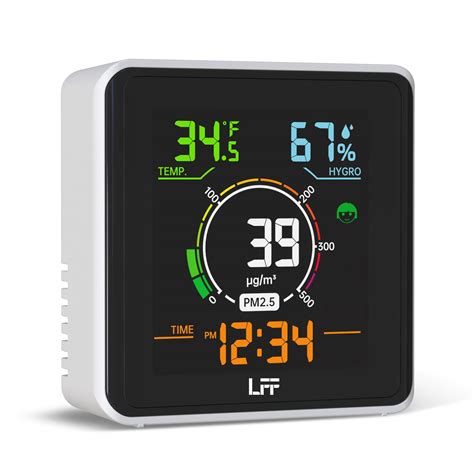What are Air Quality Sensors?
Air quality sensors are electronic devices that detect and measure the concentration of various pollutants in the air, such as:
- Particulate matter (PM2.5 and PM10)
- Volatile organic compounds (VOCs)
- Carbon monoxide (CO)
- Nitrogen dioxide (NO2)
- Sulfur dioxide (SO2)
- Ozone (O3)
These sensors convert the presence of pollutants into electrical signals, which are then processed and interpreted to provide readable data about air quality.
Types of Air Quality Sensors
There are several types of air quality sensors available, each designed to detect specific pollutants. Some of the most common types include:
1. Optical Sensors
Optical sensors use light scattering techniques to detect and measure particulate matter in the air. They work by illuminating the air sample with a laser or LED and measuring the amount of light scattered by the particles. Examples include:
- Light scattering sensors
- Nephelometers
- Optical particle counters
2. Chemical Sensors
Chemical sensors detect the presence of specific gases in the air by measuring changes in electrical properties or through chemical reactions. Some common chemical sensors are:
- Electrochemical sensors
- Metal oxide semiconductor sensors
- Non-dispersive infrared (NDIR) sensors
- Photoionization detectors (PID)
3. Biological Sensors
Biological sensors use living organisms or biological materials to detect the presence of pollutants in the air. These sensors are less common but can be used to detect specific biological contaminants, such as:
- Bacteria
- Viruses
- Fungi
- Allergens
How Air Quality Sensors Work
The working principle of air quality sensors varies depending on the type of sensor and the pollutants it is designed to detect. However, most sensors follow a general process:
-
Air sample collection: The sensor draws in an air sample from the environment.
-
Pollutant detection: The sensor uses a specific detection method (e.g., light scattering, chemical reaction, or biological interaction) to identify the presence and concentration of pollutants in the air sample.
-
Signal conversion: The sensor converts the detected pollutant levels into electrical signals.
-
Data processing: The electrical signals are processed and converted into readable data, such as pollutant concentrations in parts per million (ppm) or micrograms per cubic meter (µg/m³).
-
Data output: The processed data is displayed on the sensor’s screen or transmitted to a connected device or network for further analysis and monitoring.

Applications of Air Quality Sensors
Air quality sensors have a wide range of applications, including:
1. Indoor Air Quality Monitoring
Air quality sensors can be used to monitor the air quality in homes, offices, schools, and other indoor environments. They help identify sources of indoor air pollution, such as:
- Volatile organic compounds (VOCs) from cleaning products, paints, and furniture
- Carbon monoxide from faulty heating systems or appliances
- Particulate matter from smoking, cooking, or pet dander
By monitoring indoor air quality, people can take steps to reduce their exposure to harmful pollutants and improve their health and well-being.
2. Outdoor Air Quality Monitoring
Air quality sensors are also used to monitor outdoor air quality in cities, industrial areas, and other locations. They provide real-time data on pollutant levels, which can be used to:
- Inform public health decisions
- Develop air quality management strategies
- Identify sources of air pollution
- Alert the public during air quality emergencies
Outdoor air quality monitoring networks, such as the U.S. Environmental Protection Agency’s (EPA) AirNow system, rely on data from numerous air quality sensors to provide accurate and up-to-date information on air quality across the country.
3. Industrial Emissions Monitoring
Air quality sensors are used in industrial settings to monitor emissions from manufacturing processes, power plants, and other sources. They help ensure compliance with air quality regulations and can be used to:
- Detect leaks or malfunctions in emission control systems
- Optimize industrial processes to reduce emissions
- Provide data for regulatory reporting
Industrial emissions monitoring is critical for protecting public health and the environment from the harmful effects of air pollution.
4. Personal Exposure Monitoring
Wearable air quality sensors allow individuals to monitor their personal exposure to air pollutants throughout the day. These sensors can be integrated into smartwatches, clothing, or other accessories and provide real-time data on the user’s exposure to pollutants such as particulate matter, VOCs, and carbon monoxide.
Personal exposure monitoring can help individuals identify sources of air pollution in their daily lives and take steps to reduce their exposure, such as avoiding heavily polluted areas or adjusting their activities during high-pollution events.
Benefits of Air Quality Sensors
Air quality sensors offer numerous benefits, including:
-
Improved public health: By providing real-time data on air quality, sensors can help individuals and communities take steps to reduce their exposure to harmful pollutants and improve their health.
-
Enhanced environmental protection: Air quality sensors can help identify sources of air pollution and inform strategies to reduce emissions and protect the environment.
-
Increased awareness: By making air quality data more accessible and understandable, sensors can help raise awareness about the importance of clean air and the impact of air pollution on health and the environment.
-
Better decision-making: Air quality data from sensors can inform public health decisions, urban planning, and environmental policies, leading to more effective solutions to air pollution problems.
-
Cost-effective monitoring: Air quality sensors are often more cost-effective than traditional monitoring methods, making it possible to deploy more sensors and obtain more comprehensive data on air quality.
FAQ
1. How accurate are air quality sensors?
The accuracy of air quality sensors varies depending on the type of sensor and the pollutants it is designed to detect. High-quality sensors can provide accurate and reliable data, but some low-cost sensors may have limitations in terms of sensitivity, selectivity, and calibration. It is important to choose sensors from reputable manufacturers and to regularly calibrate and maintain them to ensure accurate readings.
2. Can air quality sensors detect all types of pollutants?
No single air quality sensor can detect all types of pollutants. Different sensors are designed to detect specific pollutants, such as particulate matter, VOCs, or gases like carbon monoxide or nitrogen dioxide. To obtain a comprehensive assessment of air quality, it may be necessary to use multiple sensors or a multi-sensor device that can detect a range of pollutants.
3. How often should air quality sensors be calibrated?
The frequency of calibration depends on the type of sensor and the manufacturer’s recommendations. Some sensors may require calibration every few months, while others may be factory-calibrated and require less frequent adjustments. It is important to follow the manufacturer’s guidelines and to regularly check the sensor’s performance to ensure accurate readings.
4. Can air quality sensors be used outdoors?
Yes, air quality sensors can be used both indoors and outdoors. Outdoor sensors are typically designed to withstand various weather conditions and may have additional features, such as solar panels for power or wireless communication capabilities for remote monitoring.
5. How do I interpret the data from air quality sensors?
Air quality data is typically presented in terms of pollutant concentrations, such as parts per million (ppm) or micrograms per cubic meter (µg/m³). Different pollutants have different health and environmental effects, and there are established air quality standards and guidelines that can help interpret the data. For example, the U.S. EPA has set National Ambient Air Quality Standards (NAAQS) for six common air pollutants, which can be used as a reference for evaluating air quality sensor data. Additionally, many air quality sensors come with mobile apps or web interfaces that provide user-friendly data visualization and interpretation tools.
Conclusion
Air quality sensors are valuable tools for monitoring and improving the air we breathe. By providing real-time data on pollutant levels, these sensors can help individuals, communities, and decision-makers take action to reduce air pollution and protect public health and the environment. As technology continues to advance, air quality sensors are becoming more accurate, affordable, and accessible, making it easier than ever to monitor and improve air quality.
With a better understanding of the types of sensors available, their working principles, and their applications, individuals and organizations can make informed decisions about how to use air quality sensors to create healthier and more sustainable environments. By prioritizing clean air and taking action to reduce pollution, we can all contribute to a better future for ourselves and the planet.
| Pollutant | Sensor Type | Measurement Range | Unit |
|---|---|---|---|
| Particulate Matter (PM2.5) | Optical | 0-1000 | µg/m³ |
| Volatile Organic Compounds (VOCs) | Metal Oxide Semiconductor | 0-1000 | ppb |
| Carbon Monoxide (CO) | Electrochemical | 0-1000 | ppm |
| Nitrogen Dioxide (NO2) | Electrochemical | 0-20 | ppm |
| Sulfur Dioxide (SO2) | Electrochemical | 0-20 | ppm |
| Ozone (O3) | Electrochemical | 0-10 | ppm |
Table 1: Common air quality sensor types, measurement ranges, and units.
| Air Quality Index (AQI) | PM2.5 (µg/m³) | Health Concern |
|---|---|---|
| 0-50 (Good) | 0-12 | Little or no risk |
| 51-100 (Moderate) | 12.1-35.4 | Acceptable quality, but some pollutants may pose a moderate health concern for sensitive groups |
| 101-150 (Unhealthy for Sensitive Groups) | 35.5-55.4 | Members of sensitive groups may experience health effects, but the general public is less likely to be affected |
| 151-200 (Unhealthy) | 55.5-150.4 | Some members of the general public may experience health effects; sensitive groups may experience more serious health effects |
| 201-300 (Very Unhealthy) | 150.5-250.4 | Health alert: The risk of health effects is increased for everyone |
| 301+ (Hazardous) | 250.5+ | Health warning of emergency conditions: Everyone is more likely to be affected |
Table 2: U.S. EPA Air Quality Index (AQI) categories, PM2.5 concentration ranges, and associated health concerns.
